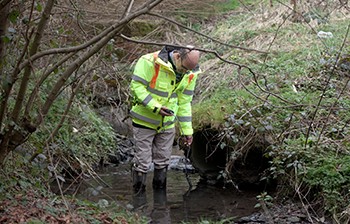Glow in the Dark Tampons: More Effective in Tracking Sewage Pollution
| Ana Verayo | | Apr 01, 2015 08:57 AM EDT |
(Photo : University of Sheffield) Professor David Lerner carrying out pollution tests
Scientists have discovered a unique idea to test waterways for sewage pollution and it involves feminine hygiene products. This method isn't only efficient but is also cheaper than the traditional conductivity and temperature meter technique.
A team of researchers from the U.K. placed tampons tied to bamboo poles in 16 surface water sewers and left them for a period of three days to detect the presence of gray water contamination produced by laundry system runoff.
Like Us on Facebook
After making the tampons run thru these sewage systems, scientists tested the tampons under a black light to detect if they absorbed optical brighteners or fluorescent whiteners derived from detergent additives. When these chemicals are present in the tampons, the white tampons glowed brighter under the black light.
David Lerner from the environmental engineering of the University of Sheffield said people will look at you strangely if you tell them you're using tampons to test for sewage pollution. Lerner also adds using tampons is also cheap and easy, detective work.
Researchers noted that more traditional methods to monitor wastewater pollution include using fiber optic cables and spectrophotometers. Not only are these costly, they also require training and obviously costs more than a box of tampons.
Since this method is now proven to be effective, the team is planning to present this to local community groups to monitor their own waterways. These efforts can trace sources of pollution and hopefully reveal unwanted sources whose ownerrs could be ordered by local law makers to clean up these polluted regions.
During the study, scientists still had to deal with well-meaning residents that removed the tampons from the poles, and that thought they were obscene or some sort of vandalism.
Apart from tying the tampons to poles, the scientists dropped the tampons in contaminated pipelines and networks in manholes along urban roads and streets. This type of water pollution is often caused by housing pipes not properly connected to sewers and it escapes into storm water systems.
This study was published in the Water and Environment Journal.
TagsGlow in the Dark Tampons: More Effective in Tracking Sewage Pollution, glow in the dark tampons, UK, sewage waterways pollution tampons glow in the dark, sewage waterways pollution, water pollution
©2015 Chinatopix All rights reserved. Do not reproduce without permission
EDITOR'S PICKS
-

Did the Trump administration just announce plans for a trade war with ‘hostile’ China and Russia?
-

US Senate passes Taiwan travel bill slammed by China
-

As Yan Sihong’s family grieves, here are other Chinese students who went missing abroad. Some have never been found
-

Beijing blasts Western critics who ‘smear China’ with the term sharp power
-

China Envoy Seeks to Defuse Tensions With U.S. as a Trade War Brews
-

Singapore's Deputy PM Provides Bitcoin Vote of Confidence Amid China's Blanket Bans
-

China warns investors over risks in overseas virtual currency trading
-

Chinese government most trustworthy: survey
-

Kashima Antlers On Course For Back-To-Back Titles
MOST POPULAR
LATEST NEWS
Zhou Yongkang: China's Former Security Chief Sentenced to Life in Prison

China's former Chief of the Ministry of Public Security, Zhou Yongkang, has been given a life sentence after he was found guilty of abusing his office, bribery and deliberately ... Full Article
TRENDING STORY

China Pork Prices Expected to Stabilize As The Supplies Recover

Elephone P9000 Smartphone is now on Sale on Amazon India

There's a Big Chance Cliffhangers Won't Still Be Resolved When Grey's Anatomy Season 13 Returns

Supreme Court Ruled on Samsung vs Apple Dispute for Patent Infringement

Microsoft Surface Pro 5 Rumors and Release Date: What is the Latest?










